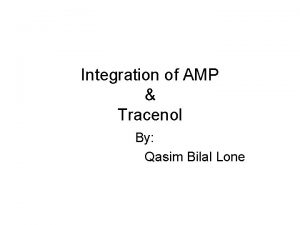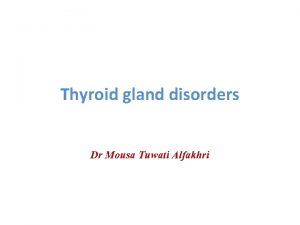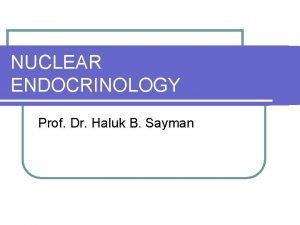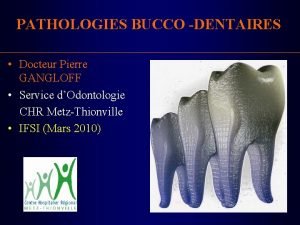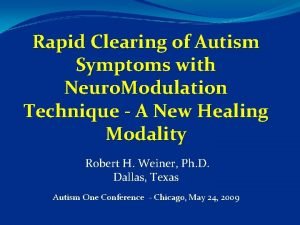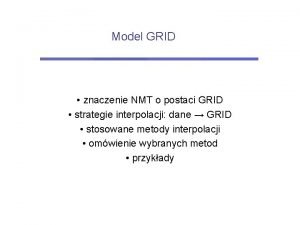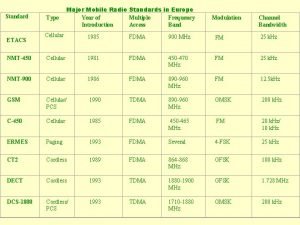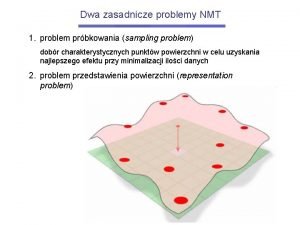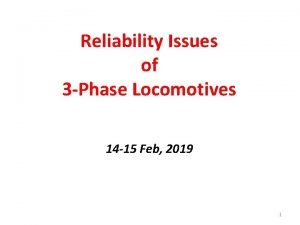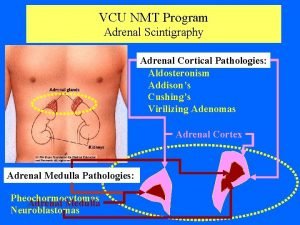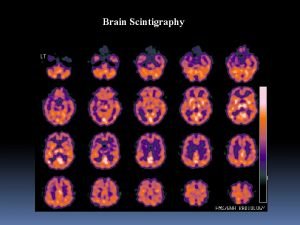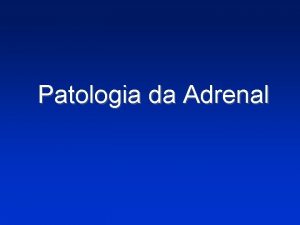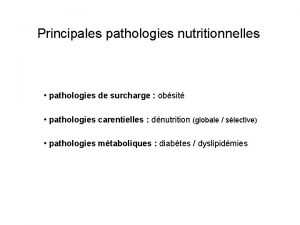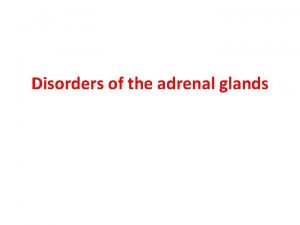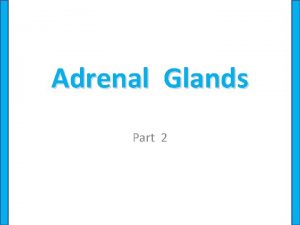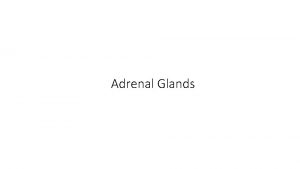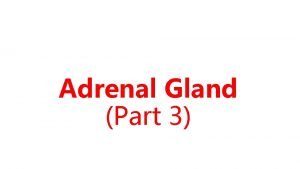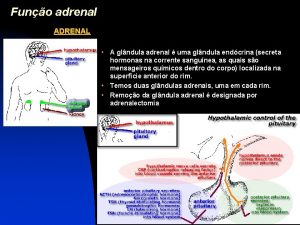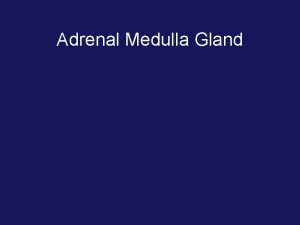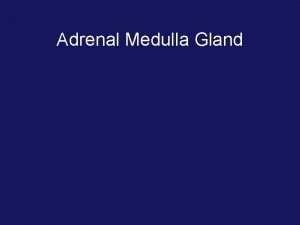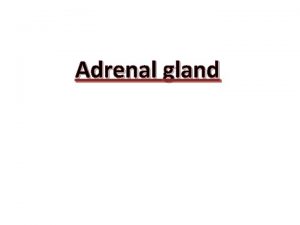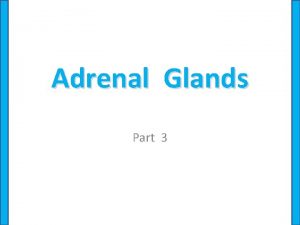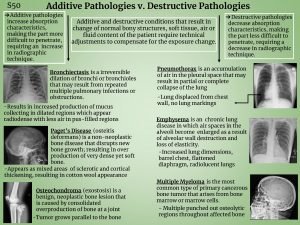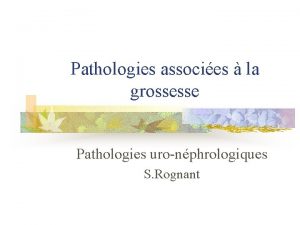VCU NMT Program Adrenal Scintigraphy Adrenal Cortical Pathologies


















- Slides: 18

VCU NMT Program Adrenal Scintigraphy Adrenal Cortical Pathologies: Aldosteronism Addison’s Cushing’s Virilizing Adenomas Adrenal Cortex Adrenal Medulla Pathologies: Pheochormocytomas Adrenal Medulla Neuroblastomas

VCU NMT Program Adrenal Scintigraphy Adrenal cortical pathologies may be evaluated using NP-59, which is a form of cholesterol, labeled with I 131. Since the adrenal cortex uses cholesterol to produce hormones, the adrenal cortex will concentrate the NP-59 labeled I 131 is rarely used in the clinical environment due to poor target to background ratios, poor imaging characteristics of I 131, and difficulty in interpretation of results.

VCU NMT Program Adrenal Scintigraphy Specific points which you should remember: NP-59 should only be used for Adrenal Cortical pathologies. Before administering NP-59 the patient should be treated with Lugol’s solution which blocks thyroid uptake of free I 131. Lugol’s administration should continue for 7 days. Administration of NP-59 I 131 should be slow to prevent allergic reactions.

VCU NMT Program Adrenal Scintigraphy Adrenal Medulla imaging for determination of Medullar metastatic lesions is performed with I 131 labeled m. IBG, or I 123 labeled m. IBG which is not commercially available at this time. Detection of adrenal medulla activity is primarily used in the evaluation of neuroblastoma and pheochromocytoma.

VCU NMT Program Adrenal Scintigraphy Neuroblastoma is a form of cancer that usually occurs in infancy and childhood. The term neuro indicates "nerves, " while blastoma refers to a cancer that affects immature or developing cells. Nearly 90% of cases are diagnosed by age 6. When detected early, neuroblastomas can usually be treated effectively. However, in as many as seven out of 10 cases, the disease is not diagnosed until it has already metastasized (spread). Overall, about 40% of children with neuroblastomas can be cured with a combination of surgery, followed by chemotherapy and/or radiation therapy.

VCU NMT Program Adrenal Scintigraphy Pheochromocytomas are vascular tumors of adrenal medulla tissue characterized by hypersecretion of epinephrine and norepinephrine. This condition puts the patient in a prolonged version of flight or flight and ultimately wears the body down. Pheochromocytomas may be found in the adrenal medulla or as metastatic tumors along the sympathetic ganglia (throughout the thorax and abdomen, but commonly along the vertebra and aorta).

VCU NMT Program Adrenal Scintigraphy Specific points which you should remember: • m. IBG should only be used for Adrenal Medulla pathologies. • Before administering m. IBG the patient should be treated with Lugol’s solution which blocks thyroid uptake of free I 131. • Lugol’s administration should continue for 6 -7 days. • Administration of NP-59 I 131 should be slow to prevent reactions. • Many drugs interfere with uptake of m. IBG in medulla tissue. 1. areas antidepressants • Normal of uptake include salivary glands, liver, spleen, 2. antihypertensives heart, GI tract, and bladder. Obtain a complete list of medications 3. sympathomimetic: • Sequential imaging should be performed toradiologist. help identify normal and check with decongestants vs. abnormal uptake. cocaine • Empty bladder speed before imaging.

VCU NMT Program Adrenal Scintigraphy Review Adrenal Medulla Pathologies: Pheochormocytomas Neuroblastomas m. IBG Adrenal Cortical Pathologies: Aldosteronism Addison’s NP-59 Cushing’s Virilizing Adenomas

VCU NMT Program Adrenal Scintigraphy 24 hour m. IBG I 131 for Pheochromocytoma

VCU NMT Program Adrenal Scintigraphy 48 hour m. IBG for Pheochromocytoma

VCU NMT Program Adrenal Scintigraphy 48 hour I 131 m. IBG for Neuroblastoma

E. VCU NMT Program 72 hour I 131 m. IBG 4 year old.

VCU NMT Program Adrenal Scintigraphy 48 hour I 131 m. IBG for Neuroblastoma

VCU NMT Program Adrenal Scintigraphy Neuroblastoma in 4 yo. Wide spread metastatic evolvement of bone marrow.

VCU NMT Program Adrenal Scintigraphy Metastatic Pheochromocytoma in liver

VCU NMT Program Adrenal Scintigraphy 48 hour I 131 m. IBG for Pheochromocytoma

VCU NMT Program Adrenal Scintigraphy Generally, Neuroblastomas are imaged at 48 and 72 hours with I 131 m. IBG. Pheochormocytomas are generally imaged at 24 and 48 hours. The timing difference is largely due to Pheochromocytomas being much more vascular; therefore, they demonstrate more rapid accumulation of the radiopharmaceutical. Sequential imaging (subsequent days) helps to distinguish normal vs abnormal uptake. How?

End of Lecture Return to the Table of Content
